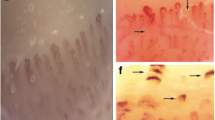Abstract
This study aimed to detect by nailfold videocapillaroscopy (NVC) the presence of age-related capillary morphological patterns in a large cohort of subjects affected by primary Raynaud’s phenomenon (PRP). NVC was performed in 877 patients affected by PRP, divided into three age groups: <35, 35–55 and >55 years. The following qualitative parameters were assessed and compared in the three groups of patients: apical dilations, irregular (non-homogeneous) dilations, venous branch dilations, microhaemorrhages, tortuosities and subpapillary venous plexus visibility. Patients with either irregular dilations or venous branch dilations were found significantly younger than those without (p < 0.0001). The presence of either irregular or venous branch dilations seems to exclude the presence of apical dilations. Patients with microhaemorrhages were found significantly younger than those without (p = 0.05), and 81 % of patients without microhaemorrhages did not show irregular and venous branch dilations. The subpapillary venous plexus seems more visible in subjects with age < 35, as well as in those with age > 55 years (p < 0.0001). A statistically significant negative correlation was found between presence of apical and irregular dilations (p < 0.0001), apical dilations and venous branch dilations (p = 0.02), apical dilations and tortuosities (p = 0.0005), microhaemorrhages and tortuosities (p < 0.0001) and venous branch dilations and tortuosities (p = 0.02). Finally, a statistically significant positive correlation was found between irregular and venous branch dilations (p < 0.0001), irregular dilations and microhaemorrhages (p < 0.0001) and venous branch dilations and microhaemorrhages (p < 0.0001). In conclusion, our study detected different age-related morphological capillary changes mainly in younger patients with PRP, as well as statistically significant correlations between the presence of different capillary variables.

Similar content being viewed by others
References
Herrick AL (2012) The pathogenesis, diagnosis and treatment of Raynaud phenomenon. Nat Rev Rheumatol 8:469–479
Herrick AL (2005) Pathogenesis of Raynaud’s phenomenon. Rheumatology (Oxford) 44:587–596
Garner R, Kumari R, Lanyon P, Doherty M, Zhang W (2015) Prevalence, risk factors and associations of primary Raynaud’s phenomenon: systematic review and meta-analysis of observational studies. BMJ Open 5:1–9
LeRoy EC, Medsger TA (1992) Raynaud’s phenomenon: a proposal for classification. Clin Exp Rheumatol 10:485–488
Cutolo M, Sulli A, Smith V (2013) How to perform and interpret capillaroscopy. Best Pract Res Clin Rheumatol 27:237–248
Sulli A, Ruaro B, Alessandri E, Pizzorni C, Cimmino MA, Zampogna G et al (2014) Correlations between nailfold microangiopathy severity, finger dermal thickness and fingertip blood perfusion in systemic sclerosis patients. Ann Rheum Dis 73:247–251
Van den Hoogen F, Khanna D, Fransen J, Johnson SR, Baron M, Tyndall A et al (2013) 2013 classification criteria for systemic sclerosis: an American College of rheumatology/European league against rheumatism collaborative initiative. Arthritis Rheum 65:2737–2747
Andrade LE, Gabriel Junior A, Assad RL, Ferrari AJ, Atra E (1990) Panoramic nailfold capillaroscopy: a new reading method and normal range. Semin Arthritis Rheum 20:21–31
Smith V, Beeckman S, Herrick AL, Decuman S, Deschepper E, De Keyser F et al (2016) An EULAR study group pilot study on reliability of simple capillaroscopic definitions to describe capillary morphology in rheumatic diseases. Rheumatology (Oxford) 55:883–890
Maricq HR (1981) Wide-field capillary microscopy. Arthritis Rheum 24:1159–1165
Lambova SN, Müller-Ladner U (2009) The role of capillaroscopy in differentiation of primary and secondary Raynaud's phenomenon in rheumatic diseases: a review of the literature and two case reports. Rheumatol Int 29:1263–1271
Bukhari M, Hollis S, Moore T, Jayson MI, Herrick AL (2000) Quantitation of microcirculatory abnormalities in patients with primary Raynaud’s phenomenon and systemic sclerosis by video capillaroscopy. Rheumatol 39:506–512
Anderson ME, Allen PD, Moore T, Hillier V, Taylor CJ, Herrick AL (2005) Computerized nailfold video capillaroscopy—a new tool for assessment of Raynaud’s phenomenon. J Rheumatol 32:841–848
Riccieri V (2010) The most frequent unusual capillaroscopic pictures in healthy subjects. In: Cutolo M (ed) Atlas of capillaroscopy in rheumatic diseases. Elsevier, Milan, pp. 55–59
Allen J (2010) Capillaroscopy in healthy subjects of different ages. In: Cutolo M (ed) Atlas of capillaroscopy in rheumatic diseases. Elsevier, Milan, pp. 49–54
Trombetta AC, Smith V, Pizzorni C, Meroni M, Paolino S, Cariti C et al (2016) Quantitative alterations of capillary diameter have a predictive value for development of the capillaroscopic systemic sclerosis pattern. J Rheumatol 43:599–606
Cutolo M, Sulli A (2015) Therapy: optimized treatment algorithms for digital vasculopathy in SSc. Nat Rev Rheumatol 11:569–571
Sulli A, Ruaro B, Smith V, Pizzorni C, Zampogna G, Gallo M et al (2013) Progression of nailfold microvascular damage and antinuclear antibody pattern in systemic sclerosis. J Rheumatol 40:634–639
Cutolo M, Pizzorni C, Sulli A (2007) Identification of transition from primary Raynaud’s phenomenon to secondary Raynaud’s phenomenon by nailfold videocapillaroscopy: comment on the article by Hirschl et al. Arthritis Rheum 56:2102–2103
Bernero E, Sulli A, Ferrari G, Ravera F, Pizzorni C, Ruaro B et al (2013) Prospective capillaroscopy-based study on transition from primary to secondary Raynaud’s phenomenon: preliminary results. Reumatismo 65:186–191
Koenig M, Joyal F, Fritzler MJ, Roussin A, Abrahamowicz M, Boire G (2008) Autoantibodies and microvascular damage are independent predictive factors for the progression of Raynaud’s phenomenon to systemic sclerosis: a twenty-year prospective study of 586 patients, with validation of proposed criteria for early systemic sclerosis. Arthritis Rheum 58:3902–3912
Author information
Authors and Affiliations
Corresponding author
Ethics declarations
Disclosures
None.
Rights and permissions
About this article
Cite this article
Pizzorni, C., Sulli, A., Smith, V. et al. Primary Raynaud’s phenomenon and nailfold videocapillaroscopy: age-related changes in capillary morphology. Clin Rheumatol 36, 1637–1642 (2017). https://doi.org/10.1007/s10067-016-3442-3
Received:
Revised:
Accepted:
Published:
Issue Date:
DOI: https://doi.org/10.1007/s10067-016-3442-3




